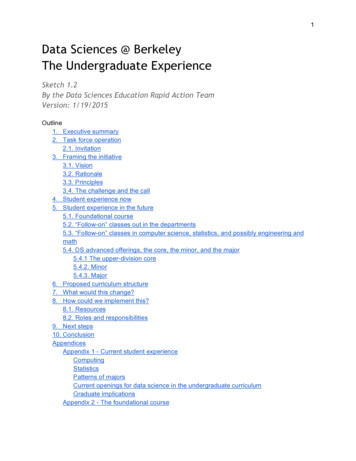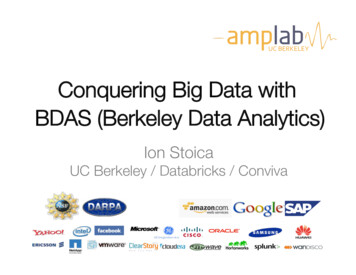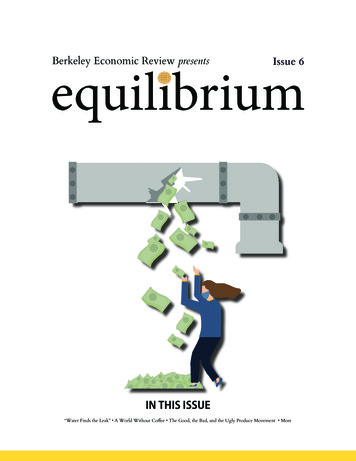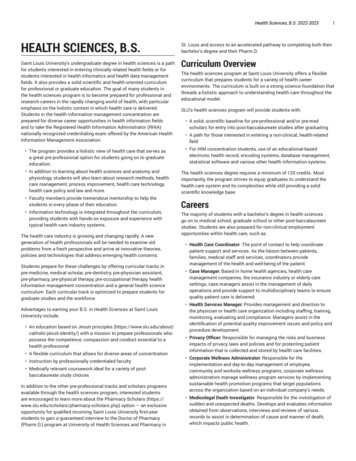
Transcription
1Data Sciences @ BerkeleyThe Undergraduate ExperienceSketch 1.2By the Data Sciences Education Rapid Action TeamVersion: 1/19/2015Outline1. Executive summary2. Task force operation2.1. Invitation3. Framing the initiative3.1. Vision3.2. Rationale3.3. Principles3.4. The challenge and the call4. Student experience now5. Student experience in the future5.1. Foundational course5.2. “Follow-on” classes out in the departments5.3. “Follow-on” classes in computer science, statistics, and possibly engineering andmath5.4. DS advanced offerings, the core, the minor, and the major5.4.1 The upper-division core5.4.2. Minor5.4.3. Major6. Proposed curriculum structure7. What would this change?8. How could we implement this?8.1. Resources8.2. Roles and responsibilities9. Next steps10. ConclusionAppendicesAppendix 1 - Current student experienceComputingStatisticsPatterns of majorsCurrent openings for data science in the undergraduate curriculumGraduate implicationsAppendix 2 - The foundational course
21.Executive summaryProviding access for our students to the fundamental structure, principles, and ramifications ofdata-analytic thinking is a key educational desideratum for an increasingly data-rich world. Thisdocument offers a concrete proposal for a curriculum that will make cutting-edge, criticalengagement with data an integral feature of a new liberal arts education and a coreinterdisciplinary capacity shared by all Berkeley undergraduates. Critical thinking with data is anarea of key importance to many fields of study, central to job opportunities in many industries,and integral to personal and professional decision-making. Tackling this challenge for ourstudents with an ambition distinctive to Berkeley means drawing on our multiple strengths,comprehensive excellence, and campus-wide scale. It represents an opportunity to markedlyimprove our students’ experience by aligning the desire to acquire data science capacities withthe structure of major programs and with course innovation. Taking off from signals of studentinterest – large inflows of students into computing and statistics classes, to start with – it createspathways through the curriculum that open doors for our students into data science in thediverse ways that respond to their future trajectories, current needs, and varied backgrounds.Based on our conversations with faculty across the Berkeley campus, we formulate a multitiered structure for a comprehensive data science education program that displays both breadthand depth.1 It is anchored in a new foundational offering, or suite of courses, intended to scaleto the entire freshman class. The foundational offering will present key elements of introductorycomputational and inferential thinking in an integrated fashion, cementing conceptualunderstanding through direct experience with data. Closely allied with this is a suite of“connector” courses, rigorously engaging many disciplinary areas by means of focused projectsand framing a critical understanding of the social and ethical context of data and analysis, whiletailoring material to the diversity of student backgrounds and interests. Built on this foundationaloffering and connectors are multiple opportunities to advance teaching and learning campuswide. Departments and programs in many areas will have the chance to evolve their curricula inways that support disciplinary learning, critical thinking about data, and undergraduate research.Likewise building on this foundation, intensive treatment of data science is rooted in a novelone-year upper-division core, which provides a gateway into both a broadly useful minor, whichcan serve students across campus, and an inventively designed major with deep coverage.These actions, taken jointly, will bring our deep campus expertise in data science research andprofessional training to serve our undergraduates. They will establish Berkeley as the leader ina national landscape of institutions that are invested in data science, none of them offering thebreadth of vision and ambition that our proposal reveals.1A schematic of the proposed curriculum is included at the end of this summary. A fullerdiscussion is found in Section 5, Student experience in the future, and Section 6, Proposedcurriculum structure.
3From our examination, the key challenges in instituting such a program also represent importantopportunities. Many majors have accumulated requirements over time and feel highlyconstrained. Accommodating and utilizing the growth of data science capacities in the studentbody will involve thoughtful re-examination. Creating a network of connections between the coreand the extensions, as well as between the minor and host majors, will require facultyengagement. That engagement is precisely what will propel our university into a 21st-centuryposture in its engagement with data across the curriculum. Indeed, the courses that thefoundational offering and the corresponding upper-division data science core displace arerooted in seminal texts of decades past; a new seminal body of teaching materials will likelyneed to come out of Berkeley. Creating this new structure will require new resources to beinvested in multiple areas, from infrastructure to curriculum design to academic staff and facultyFTE. The huge growth in demand for courses that only partially address our students’ datascience needs have already introduced severe imbalances; the systematic process of planningand resourcing can rationalize priorities.This document seeks to provide a framework for a broader discussion among Berkeley’s facultyand campus leadership. With the unique depth and breadth of Berkeley faculty in data science,development of a freshman foundational offering could begin immediately. Initial pilot offeringscould be ready as early as 2015-16 and should be on the scale of a couple hundred studentswith a handful of early-adopter connectors. An upper-division core course could be pilotedshortly after. A concerted 3- to 4-year growth and learning process would be required to refinethe foundational offerings to address the full complement of student abilities, backgrounds, andinterests. A similar timeframe would be needed to build out follow-on opportunities in domainsacross campus, as well as flesh out key upper-division courses for the minor and major. Withagile planning and deliberate speed, Berkeley can stake a claim to leadership in transformingthis future-facing aspect of undergraduate education with signature effect.
4Student pathways through courses touched by the proposed data sciences (DS) curriculum. Time proceeds from left to right. The vertical axis spans the breadth of student interests and majors. Courses are schematically represented by boxes; research opportunities, by circles. Student pathways are marked in blue. Course content focused on DS appears in yellow with a hatched corner. Course content applying DS to application fields appears in orange.
52.Task force operationThis document is the work of a task force operating through the fall of 2014. In response tosignals of student demand and to high levels of faculty interest, the Data Sciences EducationRapid Action Team was formed mid-summer by the Chancellor and Provost. The team wasasked to move quickly and report on a short timeframe. Members are:Cathryn Carson (co-chair), Historyclcarson@berkeley.eduBob Jacobsen (co-chair), Physics and Interim Dean, jacobsen@berkeley.eduL&S Undergraduate StudiesDavid Culler, EECSculler@berkeley.eduMichael Franklin, EECSfranklin@cs.berkeley.eduMichael Jordan, EECS and Statisticsjordan@eecs.berkeley.eduAnnaLee Saxenian, Dean, School of Informationanno@ischool.berkeley.eduJasjeet Sekhon, Political Science and Statisticssekhon@berkeley.eduBin Yu, Statistics and EECSbinyu@stat.berkeley.eduIn weekly meetings since early August, we have focused on three things: understanding theBerkeley landscape, learning about initiatives at other universities, and developing a curriculumproposal. In this first round, we have been lucky enough to exploit insights from several facultyand instructors already teaching this material. We have talked with multiple deans and a subsetof department/program chairs and staff, with campus leadership, Research IT (Office of theCIO), ETS, the Library, D-Lab, and BIDS. We are especially glad to have had analyticassistance from the Office of Planning and Analysis and L&S Deans Office staff.2.1. InvitationIn line with the Chancellor and Provost’s request, our proposal has been developed on a fasttimescale. Our data collection, consultation, and design process is continuing; we are taking anexperimental and iterative approach. This document is explicitly an appeal for feedback andinput, especially helping us identify errors we have made or issues we have missed. We warmlyinvite comments to any member of the task force.We have tried putting the big picture in the main text and details in appendices. We would beglad for responses to both.
63.Framing the initiative3.1. VisionEver-growing demands on our capacity to reason reliably, intelligently, and creatively from datawill change how our students tune their academic trajectories, carry out their careers, and live intheir world. In the context of thorough-going transformations in the ways our society engageswith data, all educated individuals should be able to interpret statements of inference drawnfrom empirical data, such as those that now appear routinely in the news or in statements aboutfinancial or medical matters, and also to utilize statistical reasoning and to be able to acquire,manipulate, and process appropriate empirical data in their decision-making. To do these wellrequires certain computational abilities, as well as enough experience and understanding todistinguish causation from coincidence and avoid inferential and cognitive biases. It alsorequires understanding of how data is collected, processed, and classified in order to thinkcritically about the social and ethical implications of data. In the context of a campus-wideundergraduate curriculum that stretches across diverse fields of study and extends from entrylevel through engagement in research and capstone experiences, we owe it to our students toprovide opportunities to exercise these abilities at stages from literacy to competency to masteryin preparation for the widest variety of life paths.The initiative that our task force is proposing comes amid the convergence of computation,massive new data streams, and sophisticated strategies of inference that are changing the faceof contemporary life. The “data sciences” – a toolkit of rigorous and imaginative approaches toworking with data from diverse new sources and at all scales – are emerging as instruments ofthe future for tackling a wide range of problems of intellectual, personal, and societal import.They give us new ways of grasping patterns, collectivities, and systematic effects that remaininvisible to us without statistical and computational tools; of understanding the linkages fromdata to knowledge to decision-making under conditions of uncertainty; of exploiting domainspecific computational possibilities fluidly and reliably and seeking cross-fertilization acrossthem; and of critically engaging the constructive and creative possibilities opened up by datacollection and computation, as well as their challenging ethical and social entanglements.3.2. RationaleTaking the amorphous term “data science” to point to something uniting computation, statistics,information management, and application-domain engagement with real-life data, we arepersuaded that the interdisciplinary phenomenon behind it is significant and real. More thanthat, we see the inviting possibility of embracing a reinvention of statistical education in the eraof pervasive computation. With today’s affordances we can now can give our students thechance to learn by hands-on manipulation, centered on projects using real data to integrate theteaching of computational and inferential thinking. Compared to past approaches that veered
7between abstract formalism and push-button techniques, a unified approach grounded in realworld relevance promises to make the teaching of data analysis actually “stick.” Moreover,existing curricula have fallen into a consumer/producer model of computational and inferentialideas, whereby statisticians, applied mathematicians, and computer scientists produce thetechniques and algorithms used by others. A better model recognizes that real-world problemdomains generate new challenges that are often best recognized by researchers who aresteeped in a domain. Similarly, producers and consumers of data were historically split but arenow sometimes integrated – often in fractured and challenging ways. Finally, real-worldrelevance raises a wide range of new issues that we have not confronted in the past anddemands the contributions of social scientists, humanists, and other scholars, ranging fromresearch design and communicating results to complex ethical challenges associated with datacollection and analysis. Thus, not only is real-world relevance likely to enliven the teaching ofdata analysis, it reflects the underlying dynamic of this domain.The payoffs for our students are targeted to their intended paths through Berkeley and beyond.While such diversity is essential and built into this proposal, we simultaneously have theopportunity to do something distinctively integrated at the campus scale. The domains that willbe informed by the data sciences in the future extend beyond academic research and dataanalytics in industry, reaching into a wide range of real-world careers. Every major on campusharbors students who will critically engage with data as producers AND consumers in individualdecision-making, civic settings, and their professional lives. We can create pathways for themout into a world that is being transformed by the possibilities of data science.Note the counter: good CS students enrolling in 218, 290 The demand for this curriculum is already making itself felt. Already the bulk of ourundergraduates are taking entry-level courses in computation and (separately) statisticalreasoning, with massive waves of enrollment reaching into the upper division. Iconically, CS61A, the introductory computer science course for majors, is expected to serve 2,500 studentsthis year. Combining CS 61A enrollments with other introductory computing offerings brings thenumber to nearly 5,000 undergraduates this year. This growth at Berkeley matches a trend seennationwide. The bulk of students enrolling in introductory computing courses, moreover,apparently do not intend to specialize in computer science (in either of Berkeley’s two CSmajors in the College of Engineering within EECS or in the College of Letters & Science), withevidence of particular growth in the social and physical sciences. In statistics, introductorycourses inside and outside the Statistics department serve more than 3,500 students and havebeen growing as well. Over the past 5 years, the number of statistics majors has grown from 80to 400; L&S CS majors from 140 to over 700; and EECS majors from 900 to over 1200, with ashift in balance from roughly equal in EE and CS to 3/4ths CS. Remarkably, too, the number ofstudents across campus investing in double majors has tripled in the last five years, the largestnumbers of them showing up in statistics, computer science (L&S), economics, appliedmathematics, and EECS. In 2013-14, the majority of undergraduates in statistics left Berkeleywith two (or more) majors.Thus there is increasing student interest in fields related to “data science,” even if students canmeet it on our campus only by mechanically assembling a series of technical offerings. While it
8will take careful empirical study to pin down the drivers, our initial inquiries into the conjunctionof student interest and societal transformations suggests that our curriculum is ripe to berethought and reconfigured. We find it inviting to do so, moreover, in the context of servingBerkeley’s full undergraduate student population. We ask the campus to envision providing thisexperience to those students who have not always felt fully welcomed into the data sciencesuntil now, addressing challenges around preparation, intellectual or disciplinary orientation, andsocial processes of inclusion and exclusion.3.3. PrinciplesOur envisioned curriculum assumes that every individual who studies at Berkeley should beprepared to understand and develop points of view based on the analysis of data as well asevaluate arguments made by others. Our students should learn to think about the personal,social, and scientific contexts in which data are gathered, and they should be able to thinkthrough the philosophical, moral and ethical, political, legal, and economic consequences oftackling individual and societal problems with this set of tools. They should learn how to ask,“Would it be possible to answer that question with the appropriate data?" and to think clearlyabout how to obtain the appropriate data. Our students should learn about the computationaland inferential underpinnings of data analysis and should learn about these underpinnings in anintegrated manner, in the context of problems that matter in the real world. In settings and atlevels appropriate to their own trajectories, they should be empowered to conduct their ownanalysis of data and to think creatively about how to work with data, as well as how tocommunicate the findings of complex data analytics to non-specialists.We can offer these opportunities to our students with Berkeley’s signature across-the-boardquality and rigorously critical engagement. Core to our proposal is the determination that ourstudents grapple with the limitations, inherent inconsistencies, and missing elements in data, theeffects these have on the inherent quality of decision-making, the methods for assessing therisks of those decisions given incomplete data and understanding, and the alternativemethodologies that may be brought in as complements. In this process we underline the criticalrole of visualization and other approaches that communicate data and analysis to assist inexploration, understanding, and decision-making. We are framing data science as a process ofdiscovery, interpretation, analysis, and extraction to underwrite choices, interpretations, anddecisions in individual, organizational, and societal settings. The data revolution raises manysocial, political and ethical issues, and the broad student population should be taught to reasoncritically about these issues.Our proposal thus grows from the following principles: The University should make it possible for all undergraduates to gain experience withdata science and encourage students to take fullest advantage. The desire to acquirethese capacities should not dictate a student’s major. Appropriate offerings should beavailable for students with the backgrounds and interests typical of a wide spectrum ofmajors.
9 Foundational course offerings that develop these computational, statistical, and criticalabilities should be available in a form that scales to the size of the entire undergraduatestudent body and is accessible across that diverse body at the lower division level.These offerings should provide a strong foundation in data literacy/numeracy and openthe door to further learning on that foundation. This foundational data science contentshould be part of the core experience of undergraduate education at Berkeley.A wide spectrum of courses should be able to take advantage of students’ foundationalcomputational, statistical, and critical capabilities in addressing data-oriented aspects ofdiverse subject matter. For example, advanced courses in many fields besidescomputing and statistics may bring in new, data-oriented modules or topics, and theyshould be encouraged to do so.Additional courses that address data science concepts in depth, up to and including theability to carry out a minor, should be available to students in many fields and accessiblewithin their major requirements.A data science major should be developed as a cohesive major in its own right. This canand should be done with the broad understanding of data science that underwrites therest of this initiative. The design of the major must be collaborative and adaptive as thedemands of the field and the needs of students evolve.Together these principles guide the formation of an overall data science education plan thatsupports the emerging needs of our students in graduate programs, professional careers, andleadership roles. Ultimately such a plan would need to be resourced, coordinated, and executedby the faculty.3.4. The challenge and the callThis curricular change would have implications for many departments, programs, and majors.Beyond sheer challenges of scale, there are intellectual and practical considerations growingfrom Berkeley’s differentiated scene. For this curriculum to be integrated with students’ needs intheir majors, it will only succeed if we have detailed discussions, program-by-program, ofexisting pathways, prerequisites, requirements, and follow-on courses. In some areas ourstudents already have packed-full schedules. Meeting their needs requires thoughtfulexploration of the ways in which existing offerings may not serve them optimally. In other areasour students need entirely new offerings, additional support, and new infrastructure. In all cases,building a curriculum for our students integrally involves the judgment and coordinatedengagement of domain-area faculty and the Academic Senate.The process calls for a data-driven approach that proceeds iteratively and experimentally,gathers quantitative and qualitative data on the student experience, and tracks the results ofinnovations. It requires deliberate attention to challenges around equity and best practicesaround inclusion, in ways that are critical to the success of the enterprise. It needs to be done ina thoughtful process of piloting and expanding offerings in a fashion that delivers high quality toour students, devising both an educational model and a campus infrastructure that works at
10scale. Finally, a data sciences curriculum requires significant investment of new resources, aswe detail below.And yet by tackling the challenge at scale, Berkeley can do something that no other universityhas imagined. That is to integrate the data sciences as a core component of liberal education.As other schools rush to create narrower data science programs, Berkeley has shown theintellectual ambition to define data science capaciously by engaging faculty members campuswide. Capitalizing on our deep strength in data science and our broad-spectrum excellence, thisprogram can be a Berkeley signature in conception as well as a defining feature of ourundergraduate education. Berkeley has a leading role to play in data science because of ourfaculty strength, our exceptional graduate programs, and our professional degree offerings. Weowe it to our undergraduates to extend the continuum of student experience to them as well.
114.Student experience nowMany students entering Berkeley today were born after the rise of the web, having grown up in aworld of continuous communication and interaction without bounds. With much of the world’sknowledge collected and indexed for search at the slightest inclination, they often acquireunderstanding by “questioning down” – searching on a thread and gleaning underlying conceptsby traversing links and searching additional fragments – rather than building up. Our studentsare subjects of continuous data analytics, with services delivering them targeted news,advertisements, social connections, and more based on observations of their actions. They areaware that their experience is modulated in this way, just as they have been exposed to thepromises opened up by the possibilities of political campaign analytics or personalized medicineand to the excitement of new techniques put to work in their areas of study. It would be nosurprise that they should see becoming an educated person to include gaining the ability togarner their own data, perform their own analytics and interpretation, and think critically aboutthe social and technical contexts within which those actions take place.Yet the current data science experience at Berkeley – gaining computational and statisticalcapabilities and applying them meaningfully to real data, with an understanding of thechallenges, pitfalls, and associated issues – is chaotic and anachronistic, as it is at most otherinstitutions. Students are gaining basic skills in large number through courses that are notdesigned for their array of needs and that pay almost no attention to the potential integration ofcomputational and inferential thinking, and only sporadically to designing intelligent researchquestions, collecting data, understanding it in context, and communicating its import.As filled out in Appendix 1, large cohorts of Berkeley students are in fact enrolling in one ofseveral courses covering introductory computing (nearly 5,000 this year) and introductorystatistics (over 3,500 this year, plus significant numbers taking statistics at community college).2The landscape of course-taking is complicated by the existence of multiple versions ofintroductory offerings inside and outside the core departments.3 From the diversity of offeringswe can conclude both the widespread need for this material and some sense that coursesinitially designed by departments to their own expectations are not necessarily serving broadercampus needs.Once admitted, Berkeley students face an immediate schism between the desire to gain basicdata and computational capabilities on the one hand, and the requirements of potential majors2The existence in several colleges (including L&S) of Quantitative Reasoning requirements thatcan be satisfied by these courses is worth noting, although it is by no means a dominant driverof student enrollments. That is true even in statistics, where most students who meet QR bycourse-taking end up satisfying the requirement.3For instance, E 7, Math 128, and Stat 133 are computing courses, while Math 10A/B(developed for biology majors and now serving psychology students) and Public Health 142provide introductory statistics content. Appendix 1 gives more details.
12of study on the other. The vast majority of undergraduates taking introductory courses in bothcomputer science and statistics are Letters & Science undeclared. This reflects both the size ofCollege and its commitment to a liberal arts education in which students gain breadth andcritical thinking before declaring a major. However, only a handful of majors recognize eithercomputer science or statistics courses as part of the major, other than as an elective or, in somecases, as a prerequisite.4 Computer Science does not even accept Statistics courses as fulfillingits own statistics requirement. Many science and engineering majors view their requirements ascompletely filling their students’ schedules, so there would be no room for a computing orstatistics course. Evidently, students take such courses anyways before declaring the major.And although many of our students work hard to gain this capability, our faculty rarely utilize it orcannot count on it, and major programs have not adapted to it. Despite the growth inintroductory computing enrollments, only a relatively small number of courses outside ofComputer Science have an introduction to computing as a prerequisite.5 Courses in manydisciplines have introductory statistics as a prerequisite, but faculty report that relying onstudents to have learned statistical thinking in those settings to be able to apply it immediately indomains is often a pedagogical mis-step. It is also worth observing that as many students asthere are who take introductory statistics or computing at Berkeley, there are also largenumbers who do not, and their distribution across areas of study and interest is not remotelyuniform. The real or perceived inaccessibility of these courses, and the lack of a commonbaseline that could build on them, undermines the ability of Berkeley faculty to set higherinstructional goals in their own domains. In particular, the current Quantitative Reasoningrequirement (which is centered in L&S and used by some other parts of campus) does not govery far toward meeting this need.6Moving further, to garner more than the most basic skills in this area requires taking severaladvanced courses that contain a lot of additional material. Tellingly, an analysis done withinComputer Science concluded that the material most important to a data science program iscontained in small sections of several of the current courses. To get these with the currentcourses involves essentially completing the major, and some fraction of students choose to dojust that. The current over-enrollment in these courses, as in Statistics, further forces thatchoice, since without declaring the major, getting a seat is these courses in unlikely.We see other important needs falling through the cracks. Undergraduate courses addressingcritical questions about data science in societal context are essentially absent from thecurriculum, leaving students to jerry-rig an interpretive frame. For guidance in working hands-on4Economics and Applied Mathematics allow either computer science or statistics courses toform an external cluster, but they cannot be combined. Statistics allows computer science to bean application cluster.5Courses outside of EECS that build on Berkeley’s introductory computing offerings can befound, to our knowledge, in Bioengineering, Chemical and Biomolecular Engineering, Civil andEnvironmental Engineering, Mechanical Engineering, and Cognitive Science.6Most L&S undergraduates who do not pass out of QR at entry, either by standar
Data Sciences @ Berkeley The Undergraduate Experience Sketch 1.2 By the Data Sciences Education Rapid Action Team Version: 1/19/2015 Outline 1. Executive summary . Taking the amorphous term "data science" to point to something uniting computation, statistics, information management, and application-domain engagement with real-life data .










